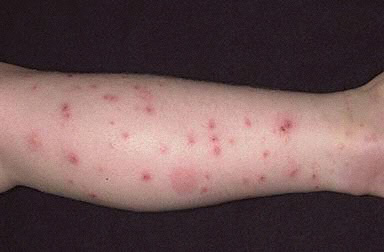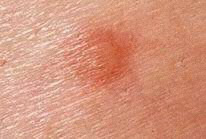Fleas are the tiny and irritating pests that can become a major problem in our homes. These parasites cause stress, variety of skin problems and increase the risk of disease transmission to our pets and our families. Fleas are more commonly noticed during warm, humid weather in the summer months (between October and March), but may become an issue at any time during the year indoors. Your pet can pick up fleas from the area of previous infestation and other cats and dogs.
 Fleas are a type of wingless insect that lives on blood of another animal. There are over 2000 species of fleas, but the most common type is the cat flea. The cat flea is found on cats and dogs.
Their general appearance is a brown, oval shaped body of about 2.5 mm in length. Their body is flattened to promote movement through the host’s hair. A host may be a cat or a dog and even a human.
Fleas have a head, mouth, two eyes, six legs and two antennae. The antennae is used to detect heat, vibration and changes in direction of air flow. The legs enable the flea to jump up to 30 cm either onto a new host or avoid threatening situations. The flea’s mouth parts use saw like jaws to cut through skin, where the fleas’ saliva contains anticoagulants to encourage blood flow. Below is a limb, which has been bitten by fleas.
To understand treatment and management strategies, it is important to understand the life cycle of the flea. The life cycle of a flea occurs in four stages. The cycle may take up to 6 months. It is highly dependant on the temperature. At 30 degrees Celsius, the flea cycle from egg to adult occurs in 12 days! The first stage is the egg (represents 50% of the flea population). The flea may lay up to 50 eggs per day and up to 1000 eggs in one lifetime. Then a worm like larvae (35 % of the flea population) hatch from the eggs and burrow into carpets and bedding. Then a cocoon is spun, where the flea pupae (10% of the flea population )is inactive and remains in the cocoon until it reaches the final stage, of an adult, begins to live and feed on blood. The adult flea may live up to 100 days. The adult stage represents only 5% of the flea population! This indicates that the flea populations continue to arise from the immature fleas.
Signs of fleas Pets are often seen scratching or biting at their skin. On inspection of your pets skin, you may notice reddened areas and pustules. (Refer to picture above) Although at times, you may not see a flea present, another sign is to watch for “black pepper” appearance or flea dirt in the pet’s coat. collect some of the specks with a paper towel. Once you have some, moisten them with water. Since flea dirt is dried blood, the specks should turn reddish brown when dissolved in water. This usually indicates that fleas are present.
The fleas may be spotted also jumping on your skin!
Check your skin as well for bites. Areas to check for extreme itchiness include: around legs, feet, waist, armpits, and creases of body parts. Red, wheals (elevated skin swellings, refer to picture, below) may develop within 30 min of the bites, which can progress to a blister or a wound after few days. The itching of a flea bite is caused by an allergic reaction, and sensitivity to them varies among people.

Management of fleas
Management of fleas in your environment include strategies for the elimination of adult fleas as well as their eggs, inside and outside of your home.
Your pest control professional will offer you ideas and treatment that will work for you and your home.
Inside the home, the fleas may be found in the carpets, bedding, pets beds. Refer to diagram on the right, the green dots indicate areas of presence of fleas in the home.
Inside the home: ensure your vacuuming is thorough: on carpets, tiles and crevices; to get rid of any eggs that are ready to hatch! Throw away the vacuum bags. Clean animal bedding thoroughly and regularly. Consider flea bombs and ensure you move the furniture around; dark areas are perfect home for flea larvae. flea_bathLook after your animals: cats and dogs. Bath the cat or dog on regular basis. Soapy water eliminates the parasites by drowning. Brush your pet’s coat on the daily basis.
Ensure your pets kennel is clean and ventilated. Fleas love humid environments. There are also many products available on the market, chemical or medicinal treatments that can significantly assist you in managing the problem. Be sure to find out what each product does before you use it. For example, there are monthly flea tablets that kill adult fleas within 30 minutes of your dog ingesting the tablet! Regular inspections of your pets skin, especially around the tail area and the back.
 Outside the home: Keep your grass trimmed low as fleas thrive in long grass. Keep your pets away from certain areas, such as: from under the house. Treat outdoor pet areas with flea insecticides.  Do not forget to have a regular pest control professional advise you about more strategies how to treat and keep your home flea free.